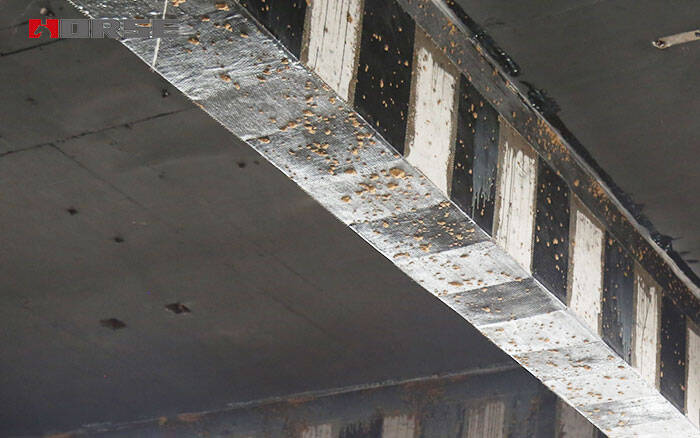Beams Strengthening
Unidirectional Carbon Fiber Sheets
First, the reinforcement plan is determined by analyzing the performance advantages of the carbon fiber sheet. Then the calculation method and construction quality control method of carbon fiber sheet structure reinforcement are researched and discussed.

1. Project Overview
A comprehensive office building in Qijiang County, Chongqing City was completed in 1999. The following problems were found during the quality inspection in August 2007:
(1) Some of the frame beams have obvious cracks in the middle of the span, with exposed ribs, and serious corrosion, causing safety hazards:
(2) The original design concrete strength is C30, and the measured concrete strength is between C20 and C30.
The project is due to poor construction quality which affected the strength of the components. However, the office building can still be used after the reinforcement of the relevant frame beams.
2. Performance analysis of carbon fiber sheet and determination of reinforcement plan
2.1. Performance advantages of carbon fiber sheet
(1) Lightweight and high strength. Light weight, basically does not increase the weight of the reinforced structure. High strength, its tensile strength is about 10 times that of steel. Especially high-elastic model carbon fiber, its tensile strength is 68 times larger than steel, and its elastic modulus is 2.0 times to 2.6 times larger than steel.
(2) High durability. Its performance remains unchanged at a high temperature of 600~3, and it is still flexible at a low temperature of 0°C in an aluminum alloy; it does not corrode with acids, alkalis, and salts in harsh environments.
(3) Good construction. Because the carbon fiber sheet is light in weight, foldable and bendable, different shapes of components can be used, and the molding is very convenient, and several layers can be pasted according to the force.
(4) The coefficient of thermal expansion is small. The thermal expansion coefficient of carbon fiber material is very small, and its thermal expansion coefficient in the fiber direction is almost equal to zero. This feature is unmatched by any other material at present. Although the coefficient of thermal expansion perpendicular to the fiber direction is relatively large, the isotropic product is the smallest compared to other materials.
2.2. The reinforcement plan of this project is determined
According to the technological requirements of several commonly used reinforcement methods and the specific conditions of the project, and comprehensive consideration of economic factors, the elimination method is adopted to determine the final reinforcement plan.
First of all, because the building is mainly for office use, the storey height is low, so for the enlarged surface method, it will further reduce the space used, which does not conform to the actual situation of the project, so the first one is excluded.
The second is the commonly used bonding steel reinforcement. It is necessary to use rubber expansion bolts to close the steel plate and the concrete beam surface at a certain distance along the longitudinal direction of the steel plate. This requires a large number of holes to be drilled on the surface of the concrete beam. As the comprehensive office building is next to the home for the elderly in Qijiang County, the drilling noise will inevitably have a serious impact on the surrounding residents. Therefore, the bonding steel reinforcement method is also excluded.
Third, the pre-stressed reinforcement method is also excluded because of its high requirements for construction equipment, cumbersome on-site construction, and relatively high cost.
3. Carbon fiber sheet reinforcement design
3.1. The basic guiding ideology of the reinforcement design of this project The concrete protective layer of part of the frame beams of the comprehensive office building has cracked, causing serious corrosion of steel bars, reducing the cross-sectional area of the steel bars, the strength of the steel bars, and the bonding strength between the steel bars and the concrete. In the case of carbon fiber reinforcement, the number of longitudinal carbon fiber sheets should be calculated according to the degree of structural corrosion to improve the bending resistance: calculate the number of transverse carbon fiber sheets to improve the shear resistance.
3.2. Anchorage length
There is an effective anchorage length for the bonding performance between CFRP sheet and concrete in terms of variable distribution or stress distribution. It can be seen from the graph of the distance between strain and crack that, except for the difference in numerical value, the shape of the curve is very similar, indicating that the strain and stress in the carbon fiber sheet are developing steadily. At the same time, the bonding strain and stress mainly change significantly within 50mm from the crack, which can explain that the bonding and anchoring length of the carbon fiber sheet is about 100mm.
The width of the frame beam and the secondary beam of this project are both 250mm. Substituting the relevant parameters into the above formula to calculate that 2 layers of 200mm wide and 0.111mm thick carbon fiber sheets need to be pasted along the bottom of the beam. The top of the beam is pasted with two layers of 200mm wide and 0.111mm thick carbon fiber sheets within 1/3 of the beam span, and 100mm wide longitudinal carbon fiber sheet bead is used for anchoring.